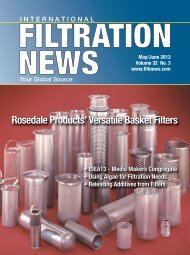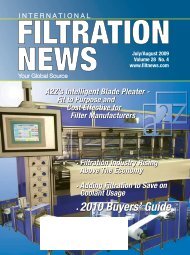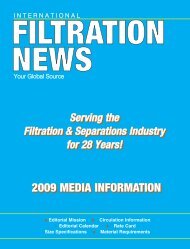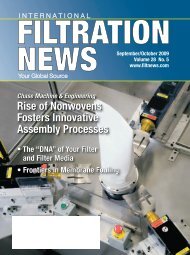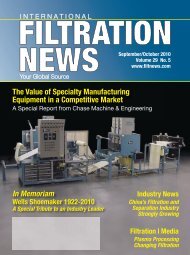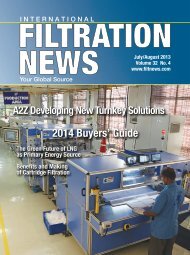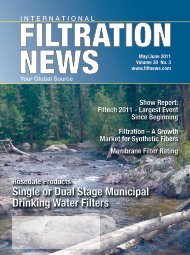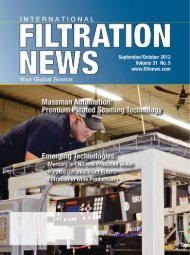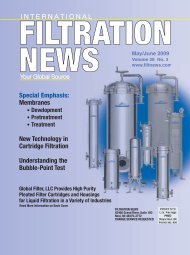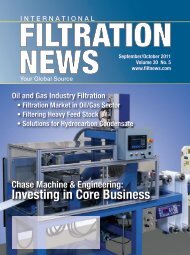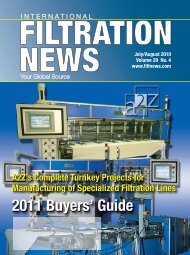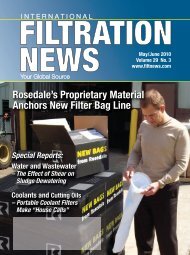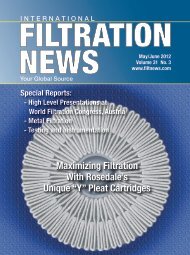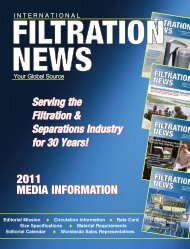2013 Buyers' Guide 2013 Buyers' Guide - Filtration News
2013 Buyers' Guide 2013 Buyers' Guide - Filtration News
2013 Buyers' Guide 2013 Buyers' Guide - Filtration News
Create successful ePaper yourself
Turn your PDF publications into a flip-book with our unique Google optimized e-Paper software.
Absorbents | Adsorbents<br />
table salt) can absorb and retain extremely<br />
large amounts of a liquid relative<br />
to their own mass. Additionally,<br />
a SAPs ability to absorb water is a<br />
factor of the ionic concentration of<br />
the aqueous solution. In deionized<br />
and distilled water, a SAP may absorb<br />
500 times its weight (from 30–60<br />
times its own volume), but when put<br />
into a 0.9% saline solution, the absorbency<br />
drops to maybe 50 times its<br />
weight. It is SAPs ability to absorb<br />
aqueous solutions through hydrogen<br />
bonding with water molecules that<br />
make them so attractive for water removal<br />
applications. This SAP affinity<br />
for water results in the water molecules<br />
becoming “trapped” as they<br />
contact the polymer and the SAP particle<br />
expands. The isolated water remains<br />
held in the Gelok laminate<br />
media layer and the decontaminated<br />
hydrocarbon fluid proceeds unaffected<br />
through the system.<br />
Gelok media is best suited as a<br />
cost-effective means of dealing with<br />
small systems that require polishing<br />
to remove or monitor moisture. It<br />
has the advantage of controlling two<br />
of the three forms of water contamination<br />
common to hydrocarbon fluids<br />
while also offering an<br />
opportunity to trap solid forms of<br />
contamination. Hydraulic system<br />
mobile machines or monitoring systems<br />
that only seek to identify and<br />
shut down in the presence of increased<br />
water are two applications<br />
that often employ this media type.<br />
Selection of an absorbent laminate<br />
product ultimately depends on the<br />
targeted requirements of the intended<br />
application. It is important to<br />
bear in mind that super absorbent filters<br />
can remove only a limited volume<br />
of water before causing the filter<br />
to go into pressure-drop induced bypass.<br />
Therefore, media identification<br />
to match the application is essential<br />
to successful filter design. The following<br />
table outlines just a portion of<br />
the considerations that Gelok must<br />
review with all customers when identifying<br />
the correct super absorbent<br />
polymer and substrate combinations<br />
for any given application.<br />
Application Considerations:<br />
• Intended use setting<br />
• Fluid type<br />
• Filter type<br />
• Fluid flow<br />
• Salinity level of the water<br />
• Desired response<br />
Polymer Considerations:<br />
• Speed of SAP response to water<br />
• Total loading of SAP (range<br />
from 10 gsm to 300 gsm)<br />
• Absorbency under load (AUL)<br />
which shows how the SAP<br />
responds under pressure<br />
22 • August 2012 • www.filtnews.com



